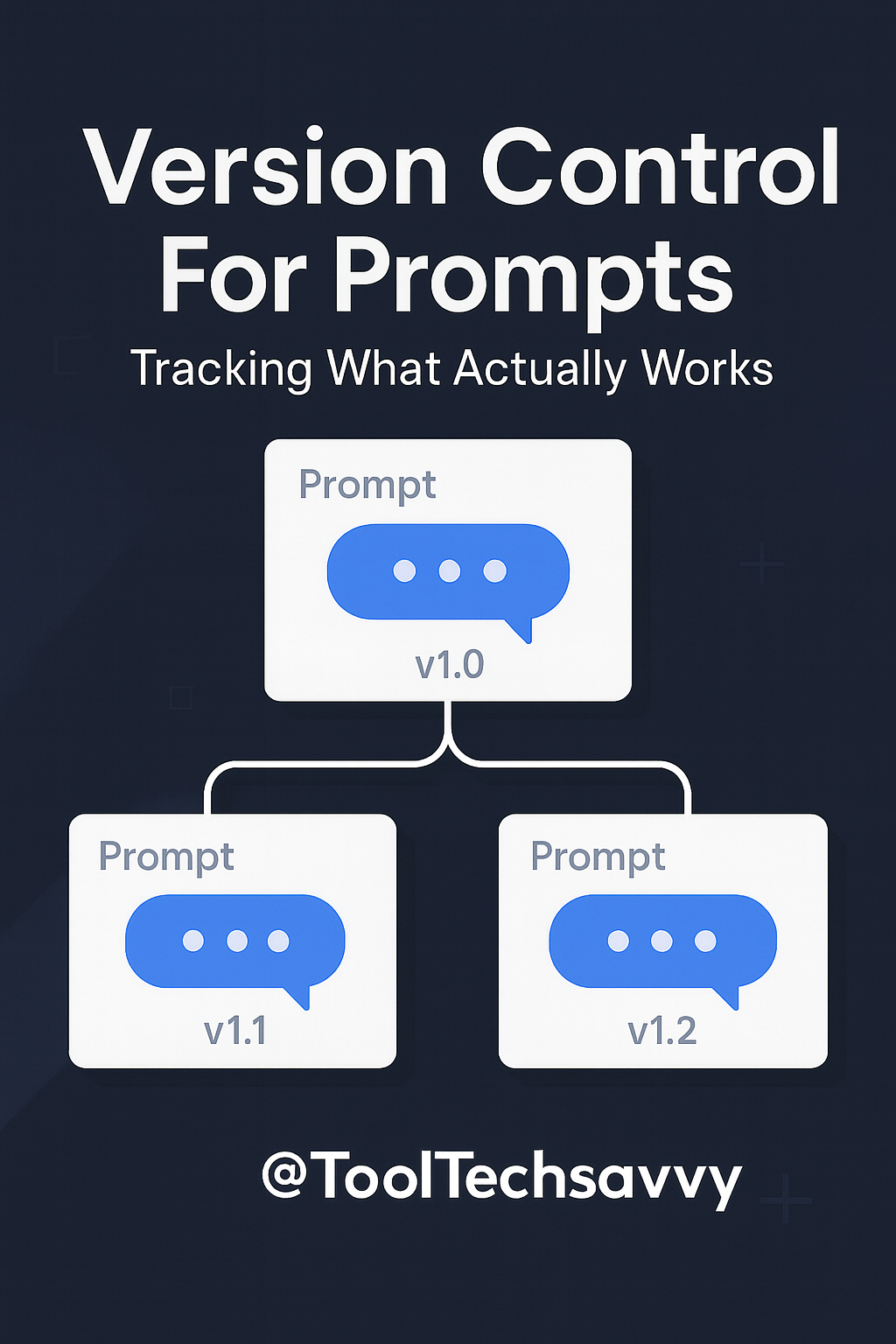Every AI creator eventually faces this: you find a prompt that works perfectly — then tweak it, test something new, and suddenly, it’s gone. You can’t remember what made it work.
That’s where version control for prompts comes in. Just as developers use Git to manage their code, AI users can apply similar principles to manage prompt evolution, track performance, and identify which version consistently delivers the best results.
If you’re already experimenting with structured prompting, you’ll love this continuation from 5 Advanced Prompt Patterns for Better AI Outputs.
Why You Need Version Control for Prompts
Prompts are the new code. Whether you’re building an AI chatbot, creating marketing copy, or automating workflows, the exact wording of your prompt determines the quality of your output.
But prompts evolve fast. You might:
- Test multiple phrasing styles for the same task
- Adjust tone, role, or constraints
- Add or remove context examples
Without version control, it’s nearly impossible to know which version worked best or why a new one performs worse.
To get better results faster, start using version control as part of your prompt design process — just like developers track changes in software.
How Prompt Versioning Actually Works
At its core, prompt versioning means saving, labeling, and comparing prompt iterations in an organized way.
Example:
v1.0 – Basic task prompt
“Summarize this text in simple language.”
v1.2 – Added tone control
“Summarize this text in a friendly, conversational tone.”
v2.0 – Added format constraint
“Summarize this text in 3 concise bullet points, friendly tone.”
When you document each change, you can clearly see what improved or worsened performance — without guesswork.
If you’re just learning how to structure and test prompts, read ChatGPT for Beginners: 7 Easy Ways to Boost Productivity with AI.
Tools You Can Use for Prompt Version Control
Here are a few practical tools and systems that make tracking prompt versions effortless:
1. Notion or Google Docs
For individual creators, these are perfect.
Create a table with columns like Prompt Version, Description, Use Case, and Performance Score.
You can even integrate this workflow using Notion + Zapier + ChatGPT: How to Create a Free AI Workflow.
2. GitHub Repositories
If you’re a developer or team, treat prompts as code.
Store them in .md files, commit changes with messages like:
“Added system role for formal tone response improvement.”
This aligns with how modern AI teams manage prompt libraries.
3. Dedicated Prompt Management Tools
New platforms like PromptLayer, Flowise, and PromptPerfect let you test, benchmark, and store prompt histories — including AI responses — so you can visually compare effectiveness.
To explore similar free tools, check out Top 5 Free AI Tools You Can Start Using Today (No Tech Skills Needed).
Key Metrics to Track
When versioning prompts, go beyond text changes — track results:
| Metric | What It Measures | Why It Matters |
|---|---|---|
| Response Accuracy | How correct or relevant outputs are | Ensures reliability |
| Tone Consistency | Whether outputs match your brand or role | Improves alignment |
| Response Length | Word count or structure adherence | Keeps results usable |
| Model Used | GPT-4, Claude, Gemini, etc. | Context for version performance |
| User Feedback | Ratings or notes | Real-world validation |
If you frequently switch between models, see How to Choose the Right AI Model for Your Workflow.
Integrating Prompt Version Control into Workflows
Prompt version control works best when it’s built into your existing AI workflow:
Step 1: Start with a Base Prompt
Build a reusable, clearly defined starting point.
Example: “You are an expert productivity coach. Rewrite this task in simple, actionable steps.”
Step 2: Create Iterations
Tweak tone, structure, or detail level.
Label each version (v1.1, v1.2, etc.) and record the result.
Step 3: Automate Your Tracking
You can automate prompt logs using Zapier or make your AI note changes automatically.
Learn how in How to Use Zapier Filters and Paths for Complex Automations.
Step 4: Review and Consolidate
Every week or project cycle, evaluate which versions perform best and why. Archive the rest.
Version Control in Agentic AI Workflows
As AI agents become smarter and more autonomous, they’ll need prompt version tracking too.
Agentic systems rely on evolving prompts that adapt through interaction and context.
To understand this shift, read How to Adopt the Agentic AI Mindset in 2025 — it explains how agents use iterative learning to refine prompts in real time.
For developers, combining prompt versioning + RAG (Retrieval-Augmented Generation) ensures agents stay accurate and consistent even as contexts change. See Unlock Smarter AI: A Beginner’s Guide to RAG and Vector Databases.
Why Version Control Makes You a Better Prompt Engineer
Prompt versioning isn’t just organization — it’s strategy.
It helps you:
- Avoid repeating mistakes
- Build reusable prompt libraries
- Measure improvements over time
- Train better AI assistants through documentation
It’s the bridge between experimentation and repeatable results — a crucial skill for anyone serious about AI productivity.
For more ways to structure your prompts like a pro, see How to Use GPTs Like a Pro: 5 Role-Based Prompts That Work.
Your Prompts Deserve a Changelog
In 2025, prompt version control will become as standard as Git is for coding.
Every iteration you save is another step toward more reliable, personalized, and high-performing AI results.
So next time your prompt works perfectly, tag it, log it, and version it.
Future you — and your AI — will thank you.
Start optimizing your prompting strategy today with 7 Proven ChatGPT Techniques Every Advanced User Should Know.



